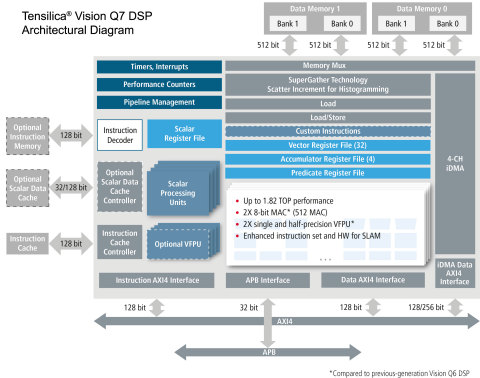Delivers up to 1.82TOPS with instruction set enhancements optimized for SLAM algorithms
SAN JOSE, Calif. — (BUSINESS WIRE) — May 15, 2019 — Cadence Design Systems, Inc. (NASDAQ: CDNS) today expanded the high end of its popular Tensilica® Vision DSP product family with the introduction of the Cadence® Tensilica Vision Q7 DSP delivering up to 1.82 tera operations per second (TOPS). To address the increasing computational requirements for embedded vision and AI applications, the sixth-generation Vision Q7 DSP provides up to 2X greater AI and floating-point performance in the same area compared to its predecessor, the Vision Q6 DSP. The Vision Q7 DSP is specifically optimized for simultaneous localization and mapping (SLAM), a technique commonly used in the robotics, drone, mobile and automotive markets to automatically construct or update a map of an unknown environment, and in the AR/VR market for inside-out tracking. For more information, visit www.cadence.com/go/visionq7.
This press release features multimedia. View the full release here: https://www.businesswire.com/news/home/20190515005193/en/

The Cadence Tensilica Vision Q7 DSP IP doubles vision and AI performance for the automotive, AR/VR, mobile and surveillance markets. Optimized for simultaneous localization and mapping (SLAM), the Vision Q7 DSP delivers up to 1.82 tera operations per second (TOPS). (Graphic: Business Wire)
Escalating demand for image sensors in edge applications is driving growth of the embedded vision market. Today’s vision use cases demand a mix of both vision and AI operations, and edge SoCs require highly flexible, high-performance vision and AI solutions operating at low power. In addition, edge applications that include an imaging camera demand a vision DSP capable of performing pre- or post-processing before any AI task. While performing SLAM, edge SoCs also require a computational offload engine to increase performance, reduce latency and further lower power for battery-operated devices. Because SLAM utilizes fixed- and floating-point arithmetic to achieve the necessary accuracy, any vision DSP employed for SLAM must provide higher performance for both data types.
With its low power and architectural and instruction set enhancements, the Vision Q7 DSP is ideally suited for the most demanding edge vision and AI processing requirements and boosts performance for a number of key metrics:
- Very long instruction word (VLIW) SIMD architecture delivers up to 1.7X higher TOPS compared to the Vision Q6 DSP in the same area
- An enhanced instruction set supporting 8/16/32-bit data types and optional VFPU support for single and half precision enables up to 2X faster performance on SLAM kernels compared to the Vision Q6 and Vision P6 DSPs
- Delivers up to 2X improvement in floating-point operations per mm2 (FLOPS/mm2) for both half precision (FP16) and single precision (FP32) compared to the Vision Q6 and Vision P6 DSPs
- Up to 2X greater AI performance in the same area compared to the Vision Q6 DSP results in up to 2X improvement in GMAC/mm2 compared to the Vision Q6 DSP
For AI applications, the Vision Q7 DSP provides a flexible solution delivering 512 8-bit MACs, compared to 256 MACs for the Vision Q6 DSP. For greater AI performance, the Vision Q7 DSP can be paired with the Tensilica DNA 100 processor. In addition to computational performance, the Vision Q7 DSP boasts a number of iDMA enhancements including 3D DMA, compression and a 256-bit AXI interface. The Vision Q7 DSP is a superset of the Vision Q6 DSP, which preserves customers’ existing software investment and enables an easy migration from the Vision Q6 or Vision P6 DSPs.
“The applications for visual AI are very diverse and are growing very fast, and these applications have huge appetites for computing performance. Achieving the required levels of performance with acceptable cost and power consumption is a common challenge, particularly as vision is increasingly deployed into cost-sensitive and battery-powered devices,” said Jeff Bier, founder of the Embedded Vision Alliance. “I applaud Cadence for its commitment to address this challenge by developing a series of processing engines tuned for the needs of visual AI applications.”
“We developed and deployed our AI and vision-based applications on the past two generations of Cadence Vision DSPs. The 2X increase in both vision and AI performance provided by the Tensilica Vision Q7 DSP will be particularly beneficial for SLAM, where low latency is key,” said Frison Xu, marketing VP at ArcSoft. “This performance increase will allow us to develop new camera applications including products with multiple image sensors.”
“Together with Cadence and our customers, we ported our face detection
and vision technology for applications where high performance, low power
and low latency are critical,” said David Shen, senior product marketing
director at Megvii. “Cadence offers one of the best vision and AI
platforms, including the necessary software tools and libraries to
showcase our technology. We look forward to leveraging the Tensilica
Vision Q7 DSP and further solidifying our collaboration with Cadence.”








